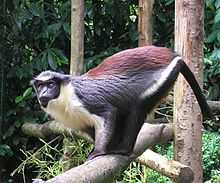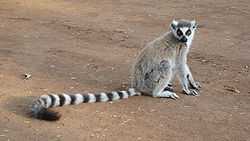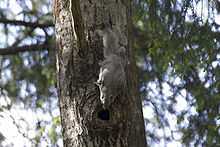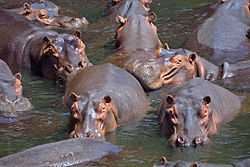Mammalia in the 10th edition of Systema Naturae
Main article: 10th edition of Systema Naturae
In the 10th edition of Systema Naturae, Carl Linnaeus described the Mammalia as one of the six classes of animals, characterized by being:[1]
Animals that suckle their young by means of lactiferous teats. In external and internal structure they resemble man: most of them are quadrupeds; and with man, their natural enemy, inhabit the surface of the Earth. The largest, though fewest in number, inhabit the ocean.
Linnaean Characteristics [1]
- Heart: 2 auricles, 2 ventricles. Warm, dark red blood
- Lungs: respires alternately
- Jaw: incombent, covered. Teeth usually within
- Teats: lactiferous
- Organs of Sense: tongue, nostrils, eyes, ears, & papillae of the skin
- Covering: hair, which is scanty in warm climates, hardly any on aquatics
- Supports: 4 feet, except in aquatics; and in most a tail. Walks on the Earth & Speaks
Linnaeus divided the mammals based upon the number, situation, and structure of their teeth.
Primates
- Fore-teeth: cutting, upper 4 parallel, (except in some species of bats which have 2 or none)
- Tusks: solitary, that is, one on each side, in each jaw
- Teats: 2 pectoral
- Feet: 2 are hands
- Nails: (usually) flattened, oval
- Food: fruits, except a few who use animal food
- Homo (humans)
- Homo sapiens – Human [2]
- Homo troglodytes – partly based on myth, partly on orangutans [3]

The Barbary macaque was named Simia sylvanus in 1758.

The Diana monkey was given the names Simia diana and Simia faunua.
- Simia satyrus – Bornean orangutan & common chimpanzee
- Simia sylvanus – Barbary macaque
- Simia sphinx – mandrill
- Simia apedia – nomen dubium
- Simia silenus – lion-tailed macaque
- Simia faunus & Simia diana – Diana monkey
- Simia paniscus – red-faced spider monkey
- Simia cephus – moustached guenon
- Simia aygula – nomen oblitum for the crab-eating macaque
- Simia hamadryas – Hamadryas baboon
- Simia jacchus – common marmoset
- Simia oedipus – cottontop tamarin
- Simia aethiops – grivet
- Simia midas – red-handed tamarin
- Simia cynamolgus – possibly crab-eating macaque
- Simia apella – tufted capuchin
- Simia morta – nomen dubium
- Simia capucina – white-headed capuchin
- Simia sciurea – common squirrel monkey
- Simia syrichta – Philippine tarsier

The ring-tailed lemur was named Lemur catta
- Lemur tardigradus – red slender loris
- Lemur catta – ring-tailed lemur
- Lemur volans – Philippine flying lemur
- Vespertilio (bats)
- Vespertilio vampyrus – large flying fox
- Vespertilio spectrum – spectral vampire bat
- Vespertilio perspicillatus – Seba's short-tailed bat
- Vespertilio spasma – lesser false vampire bat
- Vespertilio leporinus – greater bulldog bat
- Vespertilio auritus – brown long-eared bat
- Vespertilio murinus – parti-coloured bat
Bruta
- Fore-teeth: none in any jaw
- Tusks: in elephants and manatees
- Feet: with strong hoof-like nails
- Motion: slow
- Food: (mostly) masticated vegetables
- Elephas (elephants)
- Elephas maximus – Asian elephant
- Trichechus (manatees)
- Trichechus manatus – West Indian manatee
- Bradypus (sloths)
- Bradypus tridactylus – pale-throated sloth
- Bradypus didactylus – Linnaeus's two-toed sloth
- Myrmecophaga (anteaters)
- Myrmecophaga didactyla – silky anteater
- Myrmecophaga tridactyla – giant anteater
- Myrmecophaga tetradactyla – southern tamandua
- Manis (pangolins)
- Manis pentadactyla – Chinese pangolin
Ferae
- Fore-teeth: conic, usually 6 in each jaw
- Tusks: longer
- Grinders: with conic projections
- Feet: with claws
- Claws: subulate
- Food: carcasses and preying on other animals
- Phoca (seals)
- Phoca ursina – northern fur seal
- Phoca leonina – southern elephant seal
- Phoca rosmarus – walrus
- Phoca vitulina – harbour seal
- Canis familiaris – domesticated dog [4]
- Canis lupus – grey wolf
- Canis hyaena – striped hyena
- Canis vulpes & Canis alopex – red fox
- Canis lagopus – Arctic fox
- Canis aureus – golden jackal
- Felis (cats)
- Felis leo – lion
- Felis tigris – tiger
- Felis pardus – leopard
- Felis onca – jaguar
- Felis pardalis – ocelot
- Felis catus – domesticated cat [4]
- Felis lynx – Eurasian lynx
.jpg)
The eastern spotted skunk was named Viverra putorius in 1758.
- Viverra ichneumon – Egyptian mongoose
- Viverra mephitis – striped skunk
- Viverra putorius – eastern spotted skunk [5]
- Viverra zibetha – large Indian civet
- Viverra genetta – common genet
- Mustela (weasels & kin)
- Mustela lutris – sea otter
- Mustela lutra – European otter
- Mustela gulo – wolverine
- Mustela barbara – tayra
- Mustela martes – European pine marten
- Mustela putorius – European polecat
- Mustela furo – ferret [4]
- Mustela zibellina – sable
- Mustela erminea – stoat
- Ursus (bears)
- Ursus arctos – brown bear
- Ursus luscus – wolverine
- Ursus meles – European badger
- Ursus lotor – northern raccoon
Bestiae

The wild boar was named Sus scrofa in 1758.
- Fore-teeth: indefinite numbers on the sides, always have one extra canine
- Nose: elongate, used to dig
- Food: digs out juicy roots and vermin
- Sus (pigs)
- Sus scrofa – wild boar [4] & domesticated pig
- Sus porcus – red river hog
- Sus tajacu – collared peccary
- Sus babyrusa – Buru babirusa
The Brazilian three-banded armadillo was given the names Dasypus tricinctus & Dasypus quadricinctus.
- Dasypus (armadillos)
- Dasypus unicinctus – southern naked-tailed armadillo
- Dasypus tricinctus & Dasypus quadricinctus – Brazilian three-banded armadillo [6]
- Dasypus sexcinctus – six-banded armadillo
- Dasypus septemcinctus – seven-banded armadillo
- Dasypus novemcinctus – nine-banded armadillo
- Erinaceus (hedgehogs)
- Erinaceus europaeus – European hedgehog
- Talpa (moles)
- Talpa europaea – European mole
- Talpa asiatica – Cape golden mole
- Sorex (shrews)
- Sorex araneus – Common Shrew
- Sorex cristatus – Star-nosed mole
- Sorex aquaticus – Eastern Mole
- Didelphis (opossums)
- Didelphis marsupialis – common opossum
- Didelphis philander – bare-tailed woolly opossum
- Didelphis opossum – grey four-eyed opossum
- Didelphis murina & Didelphis dorsigera – Linnaeus's mouse opossum [6]
Glires
1_-_Relic38.jpg)
The Indian rhinoceros, Rhinoceros unicornis was placed in the order Glires due to the fact that the animal's incisors resembled those of rodents. [7]
- Fore-teeth: cutting, 2 in each jaw
- Tusks: none
- Feet: with claws formed for running and bounding
- Food: bark, roots, vegetables, etc, which they gnaw
- Rhinoceros (rhinoceroses)
- Rhinoceros unicornis – Indian rhinoceros
- Rhinoceros bicornis – Black rhinoceros
- Hystrix (porcupines)
- Hystrix cristata – crested porcupine
- Hystrix prehensilis – Brazilian porcupine
- Hystrix dorsata – North American porcupine
- Hystrix macroura – Asiatic brush-tailed porcupine
- Hystrix brachyura – Malayan porcupine
- Lepus timidus – mountain hare
- Lepus cuniculus – European rabbit
- Lepus capensis – Cape hare
- Lepus brasiliensis – Brazilian rabbit
- Castor (beavers)
- Castor fiber – European beaver
- Castor moschatus – Russian desman

The southern flying squirrel was named Mus volans in 1758.
- Mus (mice & kin)
- Mus porcellus – domestic guinea pig [4]
- Mus leporinus – red-rumped agouti [8]
- Mus lemmus – Norway lemming
- Mus marmota – Alpine marmot
- Mus monax – groundhog
- Mus cricetus – European hamster
- Mus amphibius & Mus terrestris – European water vole
- Mus rattus – black rat
- Mus musculus – house mouse
- Mus avellanarius – hazel dormouse
- Mus sylvaticus – wood mouse
- Mus striatus – typical striped grass mouse
- Mus longipes - midday jird [9]
- Mus jaculus – lesser Egyptian jerboa
- Mus volans – southern flying squirrel [10]

The Siberian flying squirrel was named Sciurus volans in 1758.
- Sciurus (squirrels)
- Sciurus vulgaris – red squirrel
- Sciurus niger – fox squirrel
- Sciurus cinereus – Delmarva fox squirrel
- Sciurus flavus – [nomen dubium] [11]
- Sciurus getulus – Barbary ground squirrel
- Sciurus striatus – eastern chipmunk
- Sciurus volans – Siberian flying squirrel [8]
Pecora
- Fore-teeth: no upper, lower cutting, many
- Feet: hoofed, cloven
- Food: herbs which they pluck, chews the cud
- Stomach: 4:
- the paunch to macerate and ruminate the food
- the bonnet, reticulate, to receive it,
- the omasus, or maniplies of numerous folds to digest it,
- and the abomasus', or caille, fasciate, to give it acescency and prevent putrefaction
- Camelus (camels)
- Camelus dromedarius – dromedary camel
- Camelus bactrianus – domestic Bactrian camel [4]
- Camelus glama – domestic llama [4]
- Camelus pacos – domestic alpaca [4]
- Moschus (musk deer)
- Moschus moschiferus – Siberian musk deer
- Cervus camelopardalis – giraffe
- Cervus alces – elk
- Cervus elaphus – red deer
- Cervus tarandus – reindeer
- Cervus dama – fallow deer
- Cervus bezoarticus – pampas deer
- Cervus capreolus – roe deer
- Cervus guineensis – [nomen dubium] [8]
- Capra hircus, Capra depressa, Capra reversa, & Capra mambrica – domestic goat [4][12]
- Capra ibex – Alpine ibex
- Capra rupicapra – chamois
- Capra pygmea – royal antelope
- Capra gazella – gemsbok
- Capra cervicapra – blackbuck
- Capra dorcas – Dorcas gazelle
- Capra grimmia – common duiker
- Capra ammon – argali
- Ovis (sheep)
- Bos (cattle)
- Bos taurus – domestic cattle [4]
- Bos bonasus – wisent
- Bos bison – American bison
- Bos bubalis – domestic water buffalo [4]
- Bos indicus – zebu [4]
Belluae

The hippopotamus, Hippopotamus amphibius, was named in 1758.
- Fore-teeth: obtuse
- Feet: hoofed
- Motion: heavy
- Food: gathering vegetables
- Equus (horses)
- Equus caballus – domestic horse [4]
- Equus asinus – donkey [4]
- Equus zebra – mountain zebra
- Hippopotamus (hippopotamuses)
- Hippopotamus amphibius – hippopotamus
- Hippopotamus terrestris – South American tapir
Cete
- Fins: pectoral instead of feet
- Tail: horizontal, flattened
- Claws: none
- Hair: none
- Teeth: in some cartilaginous, in some bony
- Nostrils: none, instead of which is a fistulous opening in the anterior and upper part of the head
- Food: mollusca & fish
- Habitation: the ocean
- Monodon (narwhals)
- Monodon monoceros – narwhal
- Balaena (baleen whales)
- Balaena mysticetus – bowhead whale
- Balaena physalus & Balaena boops – fin whale [14]
- Balaena musculus – Blue Whale
- Physeter (sperm whales)
- Physeter catodon, Physeter macrocephalus, Physeter miscrops & Physeter tursio – sperm whale [15]
- Delphinus phocaena – harbour porpoise
- Delphinus delphis – short-beaked common dolphin
- Delphinus orca – orca
Footnotes
References
- ↑ 1.0 1.1 Carl von Linné, translated by William Turton (1806). Volume 1. A general system of nature: through the three grand kingdoms of animals, vegetables, and minerals, systematically divided into their several classes, orders, genera, species, and varieties. London: Lackington, Allen, and Co.
- ↑ 2.0 2.1 2.2 "Carolius Linnaeus and his names for Primates". Darwiniana. Retrieved August 10, 2010.
- ↑ Bernard Wood & Mark Collard (1999). "The changing face of genus Homo". Evolutionary Anthropology 8 (6): 195–207. doi:10.1002/(SICI)1520-6505(1999)8:6<195::AID-EVAN1>3.0.CO;2-2.
- ↑ 4.0 4.1 4.2 4.3 4.4 4.5 4.6 4.7 4.8 4.9 4.10 4.11 4.12 4.13 4.14 Anthea Gentry, Juliet Clutton-Brock, Colin P. Groves (2004). "The naming of wild animal species and their domestic derivatives". Journal of Archaeological Science 31: 645–651. doi:10.1016/j.jas.2003.10.006.
- ↑ Jay Butfiloski & Tom Swaygnham. "Eastern Spotted Skunk Spilogale putorius" (PDF). South Carolina Department of Natural Resources. Retrieved August 9, 2010.
- ↑ 6.0 6.1 Alfred L. Gardner (2008). Marsupials, Xenarthrans, Shrews, and Bats. Volume 1 of Mammals of South America. University of Chicago Press. ISBN 978-0-226-28240-4.
- ↑
- ↑ 8.0 8.1 8.2 Don E. Wilson & DeeAnn M. Reeder (2005). Mammal species of the world: a taxonomic and geographic reference, Volume 1 (3rd ed.). Johns Hopkins University Press. ISBN 978-0-8018-8221-0.
- ↑ http://books.google.com/books?id=SNY-AAAAYAAJ&pg=PA157&lpg=PA157&dq=Mus+longipes+Linnaeus+1758&source=bl&ots=ziTnQYGD2o&sig=ffIcrP0yDAZPgTZ18sJsLxCwd1w&hl=en&ei=_UoBToWWGtTTgAe45pHzDQ&sa=X&oi=book_result&ct=result&resnum=8&ved=0CEUQ6AEwBw#v=onepage&q&f=false
- ↑ "Glaucomys volans (Linnaeus, 1758)". Integrated Taxonomic Information System.
- ↑ Samuel N. Rhoades (1894). "Appendix". A reprint of the North American zoology by George Ord. pp. 1–51.
- ↑ http://www.vocabularyserver.com/mammals/index.php?tema=14200776
- ↑ http://www.vocabularyserver.com/mammals/index.php?tema=14200825&/aries
- ↑ W. Perrin (2009). W. F. Perrin, ed. "Balaenoptera physalus (Linnaeus, 1758)". World Cetacea Database. World Register of Marine Species. Retrieved August 9, 2010.
- ↑ W. Perrin (2009). W. F. Perrin, ed. "Physeter macrocephalus Linnaeus, 1758". World Cetacea Database. World Register of Marine Species. Retrieved August 9, 2010.
| ||||||||||